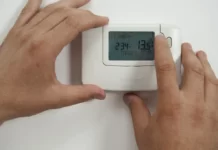What is a circuit breaker?
A circuit breaker is an electrical device designed to protect electrical circuits and equipment from damage caused by excessive current flow. It acts as a switch that automatically interrupts the electrical current when it exceeds a predetermined threshold.
A circuit breaker’s primary function is to prevent electrical circuit overloading and protect against short circuits. Overloading occurs when the amount of current flowing through a circuit exceeds the capacity of the wiring and components, which can lead to overheating and potential fire hazards. On the other hand, short circuits happen when a hot wire comes into direct contact with a neutral or ground wire, creating a path of very low resistance and causing a sudden surge of current.
3 Essential Components of a Circuit Breaker
1. Switch: The circuit breaker has an internal switch that can be manually turned on or off. The circuit is closed when the switch is in the “on” position, allowing current to flow through the connected devices. Conversely, the circuit is open when the switch is in the “off” position, interrupting the current flow.
2. Bimetallic Strip or Electromagnetic Trip Coil: Circuit breakers utilize either a bimetallic strip or an electromagnetic trip coil to detect excessive current. In the case of a bimetallic strip, it consists of two different metals with different thermal expansion rates bonded together. When excessive current passes through the circuit breaker, the strip heats up, causing it to bend and release a mechanical latch, which opens the contacts and interrupts the circuit. On the other hand, electromagnetic trip coils generate a magnetic field when an overcurrent occurs, which attracts a plunger, mechanically opening the circuit.
3. Contacts: The circuit breaker has internal contacts responsible for conducting the electrical current when the circuit is closed. When the excessive current or fault is detected, the contacts are forced apart by the mechanical mechanism triggered by the bimetallic strip or electromagnetic trip coil, thus breaking the circuit.
Once the circuit breaker has interrupted the current flow, it can be manually reset by turning the switch to the “off” position and back to the “on” position. However, it is important to identify and resolve the underlying issue that caused the circuit breaker to trip before resetting it.
In summary, a circuit breaker is a crucial safety device that protects electrical circuits from damage caused by overloading and short circuits. By monitoring the current flow and interrupting it when necessary, circuit breakers play a vital role in maintaining the safety and functionality of electrical systems.
How to Tell If a Breaker Is Bad?
Circuit breakers are essential components of our electrical systems, protecting us from potential hazards like electrical overloads and short circuits. However, circuit breakers, like any other device, can deteriorate or malfunction over time. Identifying if a breaker is bad is crucial to ensure your electrical system’s safety and proper functioning. In this guide, we will walk you through the signs that indicate a faulty breaker, whether a standard circuit breaker or a Ground Fault Circuit Interrupter (GFCI).
Signs of a Bad Circuit Breaker
1. Frequent Tripping
If a breaker trips regularly without apparent reason, it could be a sign of a faulty breaker. While occasional tripping is normal when you overload a circuit or experience a short circuit, frequent tripping without any obvious cause suggests a problem with the breaker itself.
2. Overheating
A circuit breaker that feels excessively hot to the touch may be defective. A faulty breaker can generate more heat than usual due to increased resistance within its internal components. Be cautious when checking for overheating, as excessive heat can pose a fire risk.
3. Burn Marks or Discoloration
Inspect your breaker panel for any signs of burn marks, scorching, or discoloration around the breaker. These visual indicators often point to excessive heat buildup or arcing, which can occur when a faulty breaker is overloaded.
4. Physical Damage
Any visible physical damage, such as cracks, chips, or bent components, may suggest that a breaker is compromised. Physical damage can interfere with the breaker’s proper functioning, leading to potential safety hazards.
5. Tripped Breakers Won’t Reset
If a breaker trips and refuses to reset or keeps tripping immediately after resetting, it is likely a sign of a bad breaker. This behavior indicates that the internal mechanism of the breaker is not functioning correctly and needs attention.
How to tell if GFCI is Bad – Signs of a Bad GFCI
1. No Power Supply
If your GFCI outlet does not provide power to connected devices, even after pressing the “Reset” button, it may indicate a faulty GFCI. This situation suggests that the GFCI is not detecting a ground fault or that the internal mechanism is malfunctioning.
2. Inconsistent Tripping
If your GFCI outlet trips repeatedly without any ground fault, it might indicate a defective GFCI. False tripping can happen when the internal components of the GFCI are not operating as intended.
3. Age and Wear
GFCIs have a lifespan of around 10 years. If your GFCI outlet is old or shows signs of wear and tear, it is more susceptible to malfunctions. Consider replacing older GFCIs to ensure the highest level of electrical safety.
Conclusion
I hope you’ve got the answer to your question that “how to tell if a circuit breaker is bad”. Identifying a bad breaker is crucial for maintaining a safe and reliable electrical system. By being vigilant and attentive to the signs discussed in this guide, you can assess whether your circuit breaker or GFCI requires repair or replacement. Remember to prioritize safety when dealing with electrical components and consult a qualified electrician if you are uncertain about the condition of your breakers. Regular maintenance and prompt action in addressing faulty breakers will help ensure the continued smooth operation of your electrical system while safeguarding your property and loved ones.












